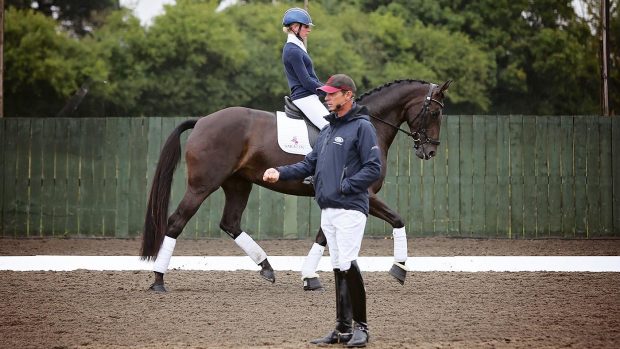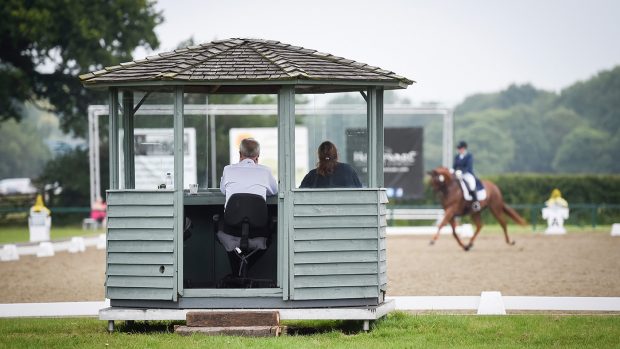Have you always wondered why judges give such varying marks? Or what you can do to help balance your big horse? Debby Lush, a List One British Dressage (BD) judge and a registered BD trainer, gives the solutions to your queries
1. How can I stop my horse tilting its head?
Q: My Irish gelding is working really well on the flat — he’s forward, soft and round. But he sometimes tilts his head to the left, especially on the left rein. How can I stop him doing this?
A: Unless your horse has sharp teeth or a worn bit, head tilting is usually a symptom of a hindleg issue. The solution depends on exactly how he tilts: whichever side his nose goes to is the problem side. Check that you don’t have a stronger contact on that side. When he tilts, deliberately lighten the contact on that side by exaggeratedly moving your hand forward. Push him more strongly with your leg on that same side — you need to get that particular hindleg to take a more energetic step forward. As his head straightens, allow him to reconnect to the contact, but only lightly: too strong a contact may block his hindleg from stepping forward correctly. In time, he will step into the contact equally without tilting.
2. How can I stop my horse pulling?
Q: My cob leans on the bit when I school her and it feels like she’s pulling my arms out of their sockets. A friend suggested putting her in a stronger bit for a couple of sessions to make her respect it more. Do you think this is a good idea?
A: It is certainly one possibility, but you should first try to discover why she leans on the bit. Is she unbalanced and on the forehand? If so, you need to use schooling exercises to help her to find more balance rather than make her even more worried by using a stronger bit. Does she understand what you want? She may need to be educated as to what response you want her to give to the bit. Is she comfortable in her bit? Discomfort often causes pulling and it may be that a change of bit shape, thickness or material might solve the problem without trying a more severe type. If you are unsure, take her to an experienced trainer who can advise you on the best course of action.
3. What are the judges looking for in transitions?
Q: Lots of novice tests I have ridden recently ask for trot-walk-trot transitions with two to five strides of walk. My pony does them really obediently, but I only ever score sixes. What are the judges particularly looking for?
A: These transitions are put into novice tests not only to check obedience, but also the correctness of a horse’s basic training. For the higher marks they need to be performed at the right place and with the required numbers of steps, but they must also show:
➤ A steady and correct outline throughout the transition, with the horse working genuinely through the back.
➤ No signs of resistance or stiffening, either physically or mentally.
➤ Increased engagement during both transitions, with the horse lowering his croup, while bringing his hindlegs further forward beneath himself in the downward transition, then springing off with energy in the upward.
➤ Good quality paces both sides of, and between, the transitions, with no shuffling or unclear steps.
➤ An enthusiastic, forward attitude.
➤ Continuous alignment to the corner or figure on which they are performed.
4. What tack rules do I need to be aware of?
Q: Why are martingales forbidden in dressage? I really want to try my hand at this discipline, but I have never ridden my cob without a martingale. What are the other tack rules I need to be aware of?
A: One of the main principles of dressage is the correct, relaxed acceptance of a direct contact between the rider’s hands and the horse’s mouth, via the reins. A martingale can affect this by applying downward pressure to the reins and possibly coercing the horse into lowering his head as a result. Hence, no martingales are allowed in dressage. You should ride your cob without one and discover how this affects his outline before you even think of entering a dressage competition. Other tack requirements will depend upon which rules you compete under: British Dressage, British Eventing, Riding Club or Pony Club, all of which tend to differ on certain items, so you should invest in the appropriate rule book. In general, no martingales, bandages or boots are allowed on your horse and only snaffle bits, or double bridles at more advanced levels. Other details do also vary.
5. How do you perform a half-pass?
Q: Can you give me some advice on how to do a half-pass? I’d love to teach my horse to do it but whenever I try, it turns into a leg yield.
A: The basic difference between leg yield and half-pass is the bend: in leg yield your horse is flexed slightly away from the direction of travel. In half-pass he must be bent towards the direction he’s going in. Prior to riding half-pass, you must be able to ride travers (haunches-in) along the track. Your horse’s head and neck should be aligned straight along the track, with his haunches slightly placed to the inside. Maintain the same rhythm and impulsion he had before starting the movement. Next, place poles on the ground in a diagonal line across the school and ride travers along this line: this is a baby half-pass. Later, increase his body bend, as his impulsion and suppleness allow, to bring him more parallel with the long side for half-pass.
Like this? You might also enjoy reading these:
25 signs you’re an incurable dressage diva/divo
6. How can I balance a big horse?
Q: I have a big-moving 17.2hh Dutch warmblood gelding who is taking time to mature and struggles with downward transitions from canter to trot. He sticks his head up in the air to balance, which I realise is because he hasn’t developed enough strength yet. I don’t want to force him into an outline, so can you suggest any exercises I can do to help him learn to carry himself?
A: You’re absolutely right not to force this issue: he is a big horse and will take longer to mature than a smaller one. Try to help him develop strength and balance in canter by riding smaller circles, at first just down to 18m, then as he finds that easier reduce them to 15m. So long as he remains upright (ie not leaning over) with a genuine bend, he will bring his inside hindleg further underneath himself, which will both improve his balance and the weight carrying capacity of his hindquarters. Make downward transitions on the smaller circles, when his hindlegs are engaged, and he should find it easier to remain in a round outline. Make a point of balancing his trot the moment he breaks into it. If you are consistent he will anticipate and begin to organise himself.
7. Why are judges’ marks so different?
Q: I’ve been to watch several championships over the last year, and I have been puzzled by how different the judges’ marks can be. We are frequently told how much training judges must undergo to reach the higher levels, yet when you have five of them around an arena all judging the same test, they often come out with wildly varying marks. Surely this can’t be right?
A: Unless you have watched from each of the judging positions you are probably unaware
of the differences in what each judge can actually see. For example:
➤ C can rule on centre line straightness and how parallel a movement is to the long side.
➤ H and M have wonderful views of each long side directly in front of them, but from neither position can the judge tell anything about a movement ridden on the diagonal directly towards them except for the horse’s straightness and rhythm.
➤ E and B can judge degree of engagement clearly in most movements but judging a half-pass is hard, as they can’t see how well a horse is crossing nor how parallel he is.
There will also always be slight differences of opinion as to which faults are more serious than others, momentary concentration lapses, or the uninvited wasp that gatecrashes the judge’s box!
8. How do I teach my horse to rein-back?
Q: How do I teach my horse rein-back? I’ve entered a novice test at an unaffiliated show and found that it has rein-back in it, but we’ve never attempted this movement before.
A: It’s a good idea to have someone on the ground to help you when teaching this movement. Halt alongside the school fence or wall and have your helper stand beside and just slightly in front of your horse’s outside shoulder. Next, apply the aids for rein-back: incline your body slightly forward to lighten your seat, take both your legs back behind the girth and squeeze gently while resisting any forward movement with the reins. Do not pull on the reins as this will make your horse stiffen. While you apply the aids, ask your helper to put a hand on the horse’s chest and push him back gently, saying the word “back”. This mirrors the commands taught for handling a horse from the ground and if he has been taught this correctly he will go backwards for your helper. In time he will learn also to associate your ridden aids with stepping calmly back and you can gradually remove the ground actions. Ask your helper to repeat the same command, but without actually touching your horse, then to stand further away, dropping the voice aid and eventually moving away altogether. By this stage you should be able to rein-back solo.
9. How do I ride a “large” walk pirouette?
Q: In medium tests, how large is a “large” walk pirouette and how do I ride one?
A: “Large” means your horse may perform a half-circle of 1m with his hindlegs. This requires less collection than a smaller half-pirouette, so you can approach from medium walk rather than collected walk. However, you will find it easier if you slightly shorten his walk steps without losing activity. Do this with repeated half-halts, not by restriction with your reins. Ask for inside bend and a feeling of shoulder-fore in the last few steps before the pirouette. When you ask him to turn, push him round with your reins, not pull. Keep your weight clearly to the inside and use your outside leg to push his haunches in. Once you are facing back the way you came, return to the track in a straight line, not sideways.



